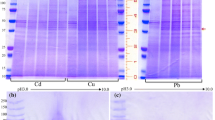Abstract
This work describes results on the characterization of cadmium binding proteins (Cd-BPs) obtained from cadmium exposed freshwater crayfishProcambarus clarkii. After acclimation to laboratory conditions, induction of Cd-BPs was achieved by water exposure at a concentration of 100 μg Cd/L during 2, 15, and 30 d: In accordance with the method followed by Engel and Brouwer, in each case two midgut glands were minced and homogenized in Tris-HCl buffer with PMSF to prevent protease activity and DTT to maintain reducing conditions. The homogenate was centrifuged, heat treated, applied to a column of Sephadex G-75, and eluted with the same buffer (pH 8.6). Absorbances of the fractions collected were measure at 245 and 280 nm. Cadmium concentrations were determined by flame photometry. In midgut glands of two-d treated crayfish, significant levels of cadmium occurred in the void volume, and no cadmium-binding protein peak was resolved. On the contrary, a cadmium peak was cleary resolved in samples of 15 and 30 d. Cadmium was accumulated in the low molecular weight fractions (about 20,000). These fractions had high ultraviolet absorption at 254 nm and a higher 254/209 ratio.
Similar content being viewed by others
References
G. Roesijadi,Mar. Environ. Res. 4, 167–179. (1980).
J. H. R. Kägi and M. Nördberg,Experientia(Suppl)34, 41–124 (1979).
R. Lyon, M. Taylor, and K. Simkiss,Comp. Biochem. Physiol. 74C, 51–54. (1983).
R. Lyon,Comp. Biochem. Physiol. 78C, 415–418 (1984).
P. S. Lake, R. Swain and B. Mills,Lethal and Sublethal Effects of Cadmium on Freshwater Crustaceans, Australian Water Resources Council Technical Paper No 37, Australian Government Publishing Service, Camberra, 1979.
M. Lalande and B. Pinel-Alloul,Sciences et Techniques de l’eau 17(3), 253–258 (1984).
J. Del Ramo, J. Diaz-Mayans, A. Torreblanca, and A. Núnez,Bull. Environ. Contam. Toxicol. 33, 736–741 (1987).
J. Díaz-Mayans, F. Hernández, J. Medina, J. Del Ramo, and A. Torreblanca,Bull. Environ. Contam. Toxicol. 37, 722–729 (1986).
V. W. T. Wong and P. S. Rainbow,Comp. Biochem. Physiol. 83A, 149–156 (1986).
D. W. Engel and M. Brouwer,Mar. Environ. Res. 13, 177–194 (1984).
J. Del Ramo, A. Pastor, A. Torreblanca, J. Medin and J. Díaz-Mayans,Bull. Environ. Contam. Toxicol. 42, 241–246 (1989).
J. R. Jennings, P. S. Rainbow, and A. G. Scott,Mar. Biol. 50, 141–149 (1979).
J. M. Frazier,Environ. Hlth. Perspect. 65, 39–43 (1986).
Author information
Authors and Affiliations
Rights and permissions
About this article
Cite this article
Del Ramo, J., Pastor, A., Torreblanca, A. et al. Cadmium binding proteins induced in exposed freshwater crayfishProcambarus clarkii . Biol Trace Elem Res 21, 75–80 (1989). https://doi.org/10.1007/BF02917238
Received:
Accepted:
Issue Date:
DOI: https://doi.org/10.1007/BF02917238




